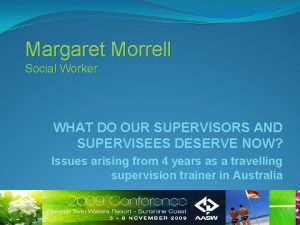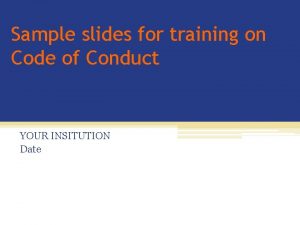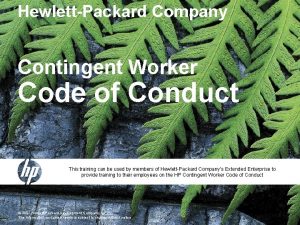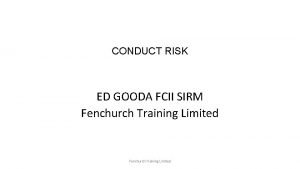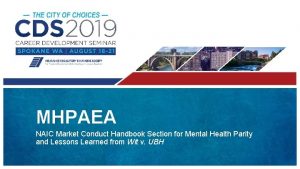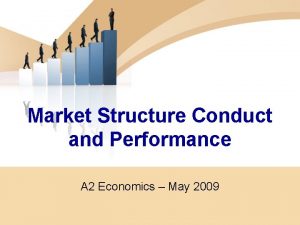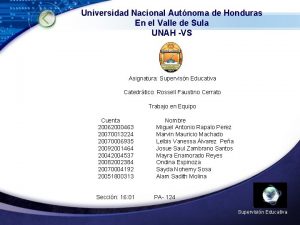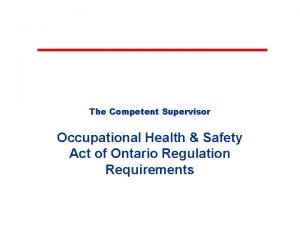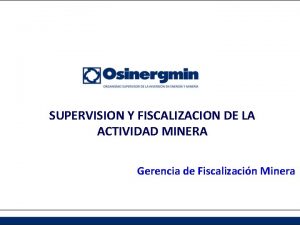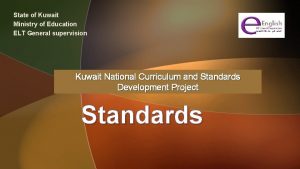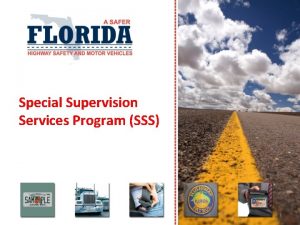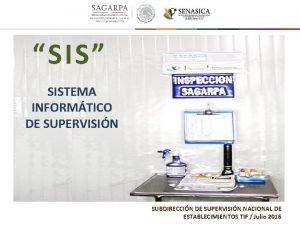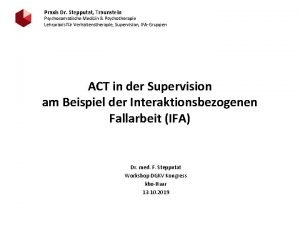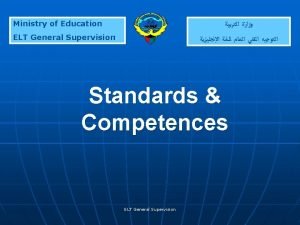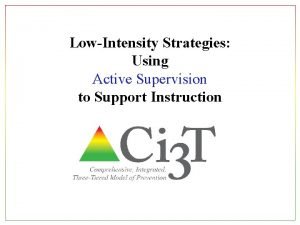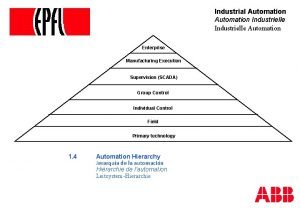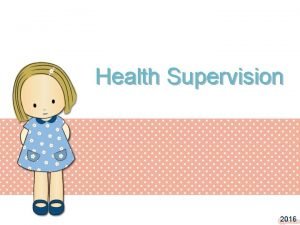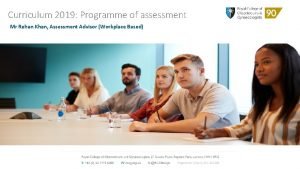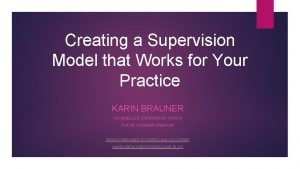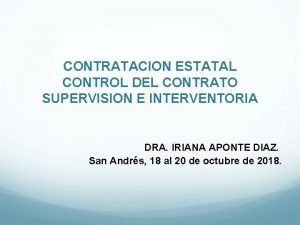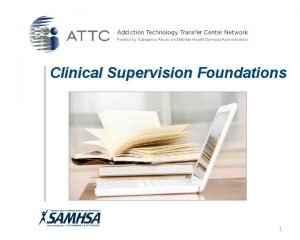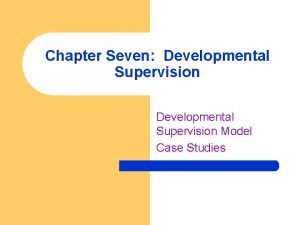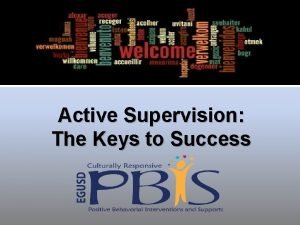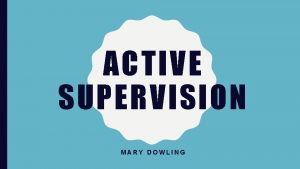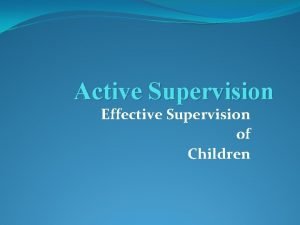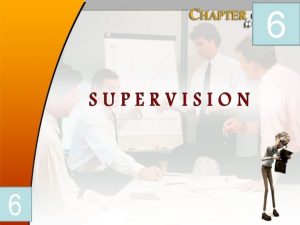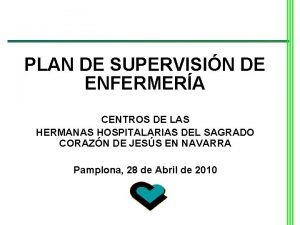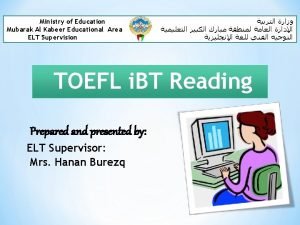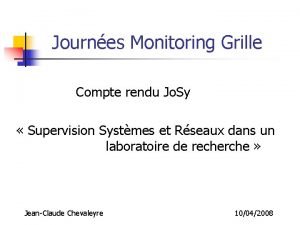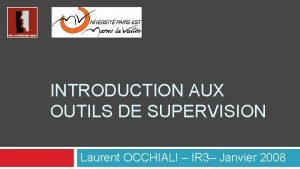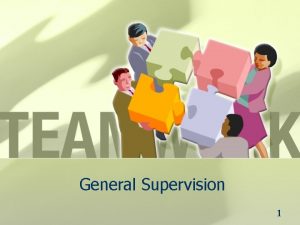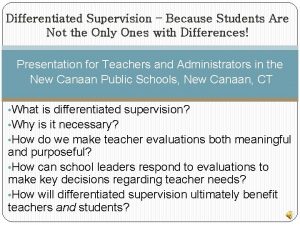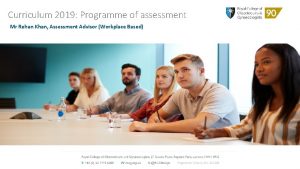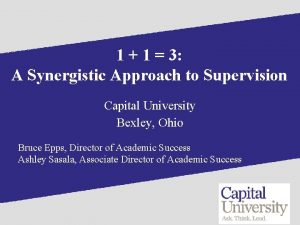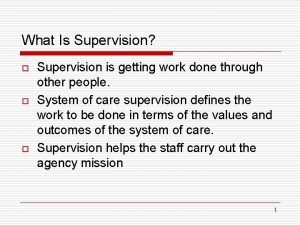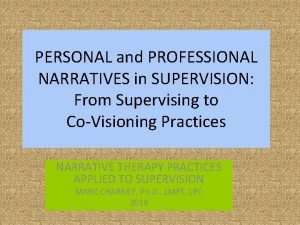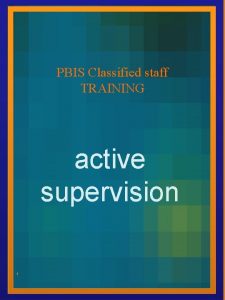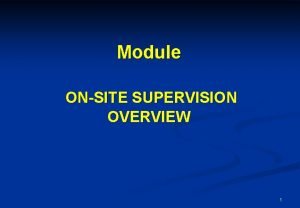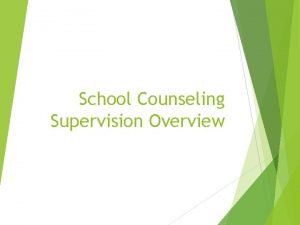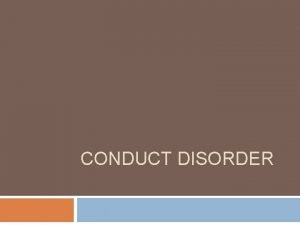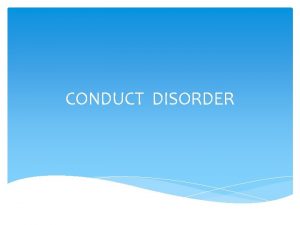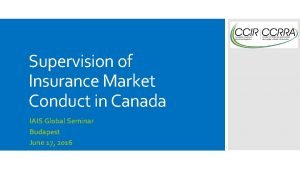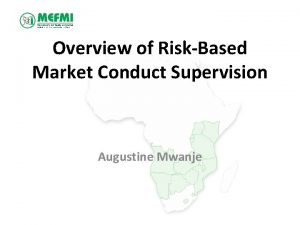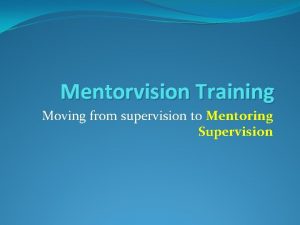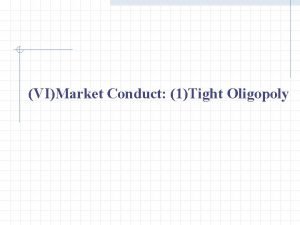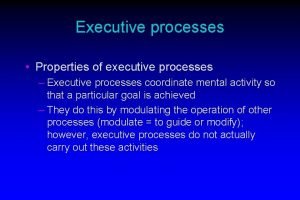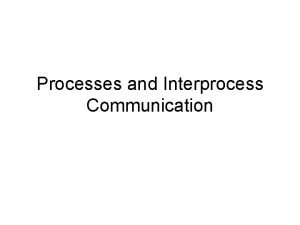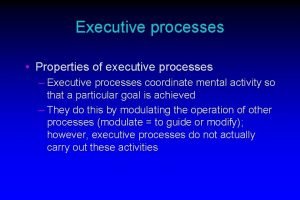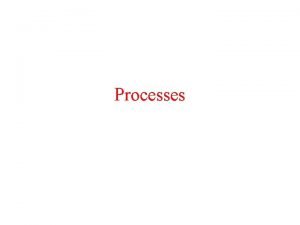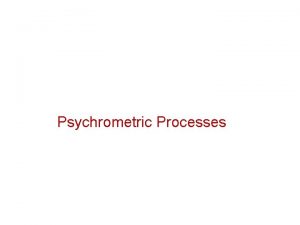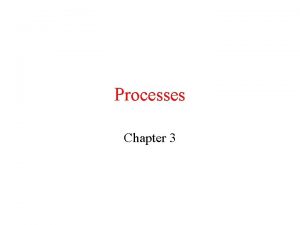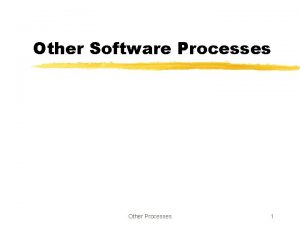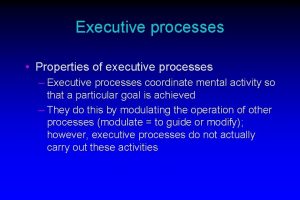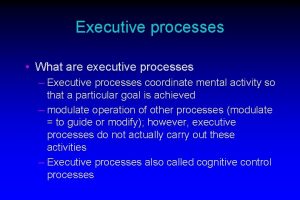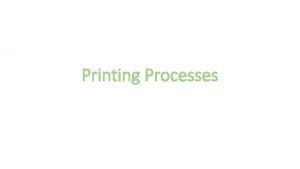MARKET CONDUCT SUPERVISION PROCESSES Market Conduct Supervision Training































































- Slides: 63

MARKET CONDUCT SUPERVISION PROCESSES Market Conduct Supervision Training Program Armenuhi Mkrtchyan 6 -10 August 2018, Harare

OVERVIEW What is MC and what is NOT Tools of Supervision Process of Supervision 2

What is Market Conduct Supervision and what is NOT?

WHAT IS MARKET CONDUCT SUPERVISION Set of policies, processes and tools used to oversite FSP activities so that they will achieve TRUST & FAIR TREATMENT and 7 MC outcomes: 1. INCLUSIVE AND COMPETIT 2. SUITABILITY IVE MARKETP LACE 3. TRANSPARENCY TRUS AND MARKETING T& 4. ETHICS FAIRAND PROFESSIONAL TREA TMEN STANDARDS T 5. DUE CARE 6. SAFETY AND SECURITY 7. LEGAL ENVIRONMENT MARKET CONDUCT POLICY OUTCOMES

MARKET CONDUCT IS NOT Making commercial decisions instead of FSP • That every firm must offer an identical level of service –businesses have different resources and ways of doing things Making commercial decisions instead of consumers • That the supervisory agency has the final say on which products consumers should want or be sold • That customers are no longer expected to make decisions or take responsibility for them Satisfying consumers • That it will create satisfied customers -> a satisfied customer could still be treated unfairly and not know it (and vice versa)

What are the TOOLS for Market Conduct supervision?

SUPERVISION TOOLS TRADITIONAL Off-site On-site Enforcement NEW TOOLS • Monitoring of webs, TV ads, publications • Inspections • • Sanctions, fines, bans Order corrective actions Suspend/terminate license Raised eyebrows & warning letters Mystery shopping • Sales, disclosure Focus Group • Disclosure – proper language, suitability, not misleading Enforceme nt • Public warning/guidance • “name and shame”

OFF-SITE MONITORING Objectives & types of off-site examinations Areas and topics for off-site examination Methodology Sources of information about financial institutions Ongoing and targeted offsite activities to monitor communication of financial institutions Follow-up actions Public guidance based on offsite examination results

OBJECTS OF OFF-SITE MARKET • What is happening in general? What are the trends? Are there any emerging issues? • All/most of institutions are involved • Establish supervisory benchmarks POLICIES • What is the main polcies? Are they comply with laws? Are they bearing consumer protection risks? • Guidelines, internal regulations, codes of conducts and policy documents of FSPs PRACTICES • What are the practices of the FSPs? • Disclosure, transparency, etc.

OBJECTIVE OF OFF-SITE • MONITOR situation/indicators that may identify problems or trigger the need for onsite inspections • Establish SUPERVISORY BENCHMARKS • VERIFY COMPLIANCE with market conduct rules and consumer protection requirements. Provide support for enforcement of rules. Provide information and background for onsite inspections • MAKE RECOMMENDATIONS for new regulations and guidance to the industry Monitor risks Supervisory benchmarks Verify compliance Make recommendations

TYPES OF OFF-SITE SUPERVISION Market Monitoring • Finding emerging issue across market 80% 20% Casework • Focus on individual FSP Thematic Review • Specific topic , market practices, and/or market segment Planned - the annual plan of examinations, quarterly/semiannually Ad-hoc - as a response to an emerging issue 11

MARKET MONITORING - TRANSPARENCY • All channels • Regularly (have a plan), quarterly, semiannually • Risky institutions and areas websites TV Radio Printed materials

CASEWORK • Focus on individual FSP • Dealing with a specific issue or general, • Reaction to consumer complaints or specific referrals from other sources EXAMPLES • Complaint Handling process of particular FSP • Agents taking illegal payments for services

THEMATIC REVIEW • Specific topic , market practices, and/or market segment • All or representative sample of FSPs • When - recent or planned market changes, complaints, effectiveness of regulation, emerging issue, etc. EXAMPLES • New regulation on KFS and its implementation • Agents taking illegal payments for services, finding which FSPs fail to comply

PROCESS OF OFFSITE 1 • Identification of FSPs and theme for supervision – Scope of review 2 • Data collection & request for information 3 • Assessment of information 4 • Enforcement 5 • Follow-up action 6 • Communication of results 15

HOW TO CHOSE INSTITUTIONS FORSUPERVISION • Institution’s current risk assessment (risk rating) • Size / market share (turnover, assets / liabilities, number of customers, distribution network) • Products offered / services provided • Public image • Diversification of samples (good practices vs. poor practices) • Emerging risks 16

DATA COLLECTION &REQUEST FOR INFORMATION There are four ways to collect data that will form the base of the supervision: • Monitoring and collection of publicly available data: The supervisor should monitor, collect and assess publicly available data (indirect offsite examination) • Regulatory Data: Data that is required from each institution by the supervisor on some periodic frequency. This could be both qualitative and quantitative (direct off-site examination) • Information request: Information is formally requested from the financial institution(direct offsite examination) • Data sharing: Relevant data available to other public authorities or entities is shared with the supervisor (and vice versa) 17

DATA COLLECTION: SOURCES OF INFORMATION • Consumer contracts and other contractual documents such as terms and conditions • Key fact statements and other disclosure documents • Internal regulations (body of internal rules) • Written policies and procedure manuals • Internal codes of conduct or industry codes of conduct • Advertising and marketing materials QUALITATIVE • Complaints reports and complaints statistics • Financial data (e. g. loan performance, deposits, etc. ) QUANTITATIVE

MYSTERY SHOPPING • • • Definition and benefits for supervisors Design and methodology Communication of results Follow-up actions Public guidance based on mystery shopping results

MYSTERY SHOPPING: DEFINITION • A technique that involves the use of individuals trained to experience and measure customer service processes by acting as potential customers and reporting back and analyzing on their experiences in a detailed and objective way • Mystery shoppers perform specific tasks such as: purchasing a product, asking questions, registering complaints; or just behaving in a certain way. • Provides a detailed insight into the way financial institutions provide services and sell products to their customers 20

OBJECTIVE OF MYSTERY SHOPPING • DISCOVER: to carry out research in an area that has been identified as potentially high risk • VERIFY: to address existing concerns about a specific financial institution or within a market segment Effective tool that enables supervisors to: • Verify and evaluate how the FI treats its customers; in regards to the implementation of regulatory requirements for market conduct • Assess levels of firms’ compliance with rules; • Examine the experience consumers have with financial institutions • Allows the supervisor to verify results of analytical work, public opinion or received complaints through an objective and independent tool

WHEN TO USE MYSTERY SHOPPING • As a supervisory tool, mystery shopping may be used to: § Identify level of compliance with existing rules – with scenarios designed to assess compliance with key regulatory provisions § Inform supervisory planning – basis for a plan for thematic inspections § Inform development of the regulatory framework 22

MYSTERY SHOPPING TECHNIQUES • There are three types of mystery shopping techniques: § Mystery visits (on-site mystery shopping in branches and other sales points used by the financial institution or its distributors) § Mystery telephone calls § Mystery e-mail requests and / or website visits • For each of the types, different tools may be used for the collection of information: § Simple questionnaires § Detailed shopping scenarios including complete audio and video recordings (if legally allowed) 23

PROCESS OF MYSTERY SHOPPING 1 • Setting objectives and goals 2 • Identification of “targets” 3 • Scenarios and questionnaires design 4 • “Defining” and training shoppers 5 • Pilot stage and evaluation of scenarios & questionnaires 6 • Data collection 7 • Analysis 8 • Summary report 9 • Follow-up actions 24

A FEW CONSIDERATIONS FOR MYSTERY SHOPPING • Credibility: The scenario must be realistic, i. e. represent natural and typical consumer behavior in the financial market: § Straightforward-easily understood and applied § Mystery shoppers should fit the profile of appropriate purchasers, and have a level of familiarity with the product • Ethicality: FIs must be aware that mystery shopping can be used by the supervisor • Safety: Mystery shoppers shall not be put at risk: • Objectivity: Should be focused on objective questions aimed at gathering factual information 25

FOCUS GROUP RESEARCH

FOCUS GROUP RESEARCH It is a form of qualitative research consisting of interviews in which a group of people are asked about their perceptions, opinions, beliefs, and attitudes towards a product, service, concept, advertisement, idea, or packaging.

IT LOOKS LIKE THIS

WHEN IT CAN BE USED When Example 1. Different opinions on the same 1. Advertisement is misleading issue during supervision 2. Design of regulation reflecting consumers perspective 3. Assessing effectiveness of existing practice 2. Key Facts Statement template 3. Existing templates for complaints handling

SELECTION OF MYSTERY SHOPPERS Mystery shoppers may be recruited from: • Supervisory staff: highly experienced and knowledgeable but more inclined to biased (as they have different focus and higher financial capability than average consumers), some supervisors may also face a capacity problem; • External appointees (outsourcing): more objective, but thorough training needed. • Volunteers – usually students 30

ON-SITE INSPECTIONS • • • Purpose of market conduct onsite supervision and types of inspections Annual work plan Preparation of an inspection Conducting inspections Inspection report and follow-ups

OBJECTIVE OF ON-SITE Verify what you know Find out what is not possible during off-site Update risk profile Make recommendations • Verify information and clarify issues collected previously to the inspection • Observe and collect information on internal control, significant activities, risks over 7 MC outcomes • Update the FSP’s risk profile • Make recommendations regarding deficiencies

OBJECTIVE OF ON-SITE People Mindset, culture • Meet, discuss and observe management and employees, understand their attitude, mindset, corporate culture over MC, Assess their understanding of the rules, what qualifications the front office has Processes Policy & Implementation, risk control • Assess how TCF is internalized by FI Business Model Riskiness • What is the model of retail activity of the FSP? What MC risks bear the business model?

TYPES OF ON-SITE INSPECTIONS Comprehensive Thematic Targeted • Full RBS - diagnostics • Cover all areas related to consumer interactions • Priorities based on risk assessment for each institution • e. g. review of redress mechanisms in the banking sector • Combined with deskreview • Focus on a particular area or product • Based on issues identified 34

Plan ON-SITE PROCESS Prepare Conduct Report Follow-up • Make an annual work plan • Make preparation for the inspection • Conduct Inspections • File the report and recommendations • Discuss it with stakeholders, FSP’s management • Follow up if recommendations are implemented by FSP

PREPARATION: COLLECTION OF INFORMATION • Be clever, seem clever: do not go to onsite inspection before knowing as much as you can • Collect as much information as possible from internal and external sources before requesting info from FI. • A) Internal, B) external sources + C) information provided by FI 36

PREPARATION: COLLECTION OF INFORMATION • Internal sources • Data regularly reported to the supervisor and off-site analysis reports • Information used to conduct the latest risk assessment • Prior inspection reports and supporting documents • Licensing information (incl. fit & proper info on management) • External sources: • Media coverage related to the institution • Internet and social media • Complaints received (both FI’s reports and external parties such as a financial ombudsman) • Advertisements • FI’s website • Any relevant previous correspondence • Complaints received about the institution 37

PREPARATION: INFORMATION REQUEST TO FI • Bank’s strategy (strategic plan) • Organizational arrangements • Manuals and policies concerning market conduct • Information about product development/approval process • Marketing programs, advertisements, similar • Internal control monitoring and auditing relevant materials • Results of relevant internal audit reviews • Sample of consumer complaints and telemarketing files/records • Compliance reports • Complaint analysis reports • Staff remuneration and incentive policies • Any relevant Board minutes • Current contract documentation of retail products 38

PREPARATION: INSPECTION PLAN The Inspection plan should identify: • Issues that will be reviewed/verified on-site • Access to complaints and other management systems • Additional documentation that may be requested on-site • Employees of the financial institution that will be interviewed/observed: • • • CEO / members of the board Front office and sales managers Compliance officer / Internal auditor Employees responsible for complaints handling Marketing, other managers 39

PREPARATION: INTERVIEW TEMPLATES • Interviews are a significant part of onsite inspections. The team should draft interview templates for each type of manager or employee selected for interviews. • Questions on position, qualification, work experience, recent trainings, reporting lines/methods • Work-related questions on tasks and responsibilities, internal rules and policies to follow, internal controls applied • Specific work-related questions according to the position of the manager / employee, and the focus of the inspection • Specific questions arising from the documentation review 40

FOLLOW UPS: INSPECTION REPORT • The primary purpose of the inspection report is: • To prepare the grounds for any necessary enforcement action • To communicate examination findings to the board of directors and senior executives of the supervised financial institution. • The inspection report should be a standalone document that will contain all relevant information to assess any potential enforcement action and at the same time inform the management of the financial institution about the results of the market conduct analysis and the legal reasons for any requested changes. 41

FOLLOW UPS: WORK PAPERS • All interviews, observations and analysis should be recorded in the supervisory team's work papers and documented in the conducted reviews. • All information collected and all records created during the inspection should be included in the work papers and their annexes (work performed during the inspection, sampling process used, findings and violations noted during the examination, copies of relevant documents). • All work papers and related documentation from the examination should be stored in an electronic form. If the supervised financial institution is able to provide a document only in hard copy form, the examiner should scan the document for future reference and return the original. 42

FOLLOW UPS: UPDATE THE IF’S RISK PROFILE • Once the inspection is over and decisions about possible corrections and / or sanctions made, the supervisory team should update the market conduct assessment matrix. • The matrix should be again updated when the supervisor verifies that the financial institution fully implemented requested changes (assuming the requested changes have an impact on the risk profile of the financial institution). 43

ENFORCEMENT

TRADITIONAL • Sanctions, fines, bans • Order corrective actions • Suspend/terminate license • Raised eyebrows & warning letters V NEW • Public warning/guidance • “name and shame”

There are some processes are important to set up regardless what tools are used

REPORTS • Any supervision action should have filed into REPORT with key findings and recommendations • Should be compiled nicely and provided to top management • Report should include: • • Key messages Consolidated analyses Analyses by institutions Recommendations and actions

DATABASE OF FINDINGS • All data should be in one place where all supervisors have access to. PURPOSE Reduce asymmetry among supervisors • Files should be compiled in an organized way by Keep institutional memory • institutions • Purposes (monitoring reports, etc) • PASSPORT/ID of each institution Increase effectiveness and efficiency of supervisors

GUIDELINES/MANUALS Manuals should be for each regular process: • Off site monitoring (web, TV, Radio…) • On-site • Mystery shopping • Database management and data recording • Hot line • …. PURPOSE Regulate processes so that minimum standards can be kept across supervisors Increase quality of coordination and cooperation level (especially between departments)

QUESTIONS? Armenuhi Mkrtchyan Head of Consumer Protection and Financial Education Centre, Central Bank of Armenia armenuhi. mkrtchyan@cba. am www. cba. am – for Armenian legislation www. abcfinance. am – financial education website

PROCESS OF SUPERVISION 1 Pre-surveilance • Use off-site and on-site thematic examinations, mystery shopping, surveys, monitor media, consumer complaints… 2 Planning • Identification of FSPs and themes for supervision, resources, scope of review, areas of focus based on risks 3 Data collection • Collect necessary data or request information from FSP or other sources 4 Assessment • Assess the situation, consult actively with all relevant parties 5 Enforcement • Ensure the supervisory action is proportionate and leads to the desired general outcome of changing the culture towards TFC 6 Follow-up • Monitor the corrective actions, actively follow up on any agreed or ordered action, assess effectiveness of the action 7 Communication of results • Communication of results 51

MC SUPERVISION • Is the set of tools the same as prudential? • What approaches – compliance vs risk-based supervision?

SUPERVISION TOOLS • Market level • Red flags/ systemic risks • Media, Complaints … • Hard tools • Soft tools • FSP level • off-site & other • all media Emerging risks Monitoring Enforcement Investigation • On-site • Mystery shopping • Focus group

SUPERVISION TOOLS prudential and market conduct tools Emerging risks • Thematic research • Red flags from media, complaints, hot line, innovations … Monitoring • Off-site • websites, social media, advertising, published information and advertising materials… Investigation • On-site • Thematic • Mystery shopping • Focus group Enforcement Hard tools • Order to eliminate violations • Financial sanctions • Suspension of the performance of the activities or profession • Withdrawal/revocatio n of license • Bring criminal charge to prosecution authority • Sanctions against management • Apply to court for an injunction • Warning letter to FSP’s management Enforcement Soft tools • Recommendations from regulator • ‘Raised eyebrow’ • Restoration – if consequences of violation removed • Persuasion through regular discussions, involvement, and effective communication with FSPs • Naming and shaming

• Still mostly used Risk based Compliance based SUPERVISION APPROACHES • MC risk (as separate) is new for SSBs • Embedded in prudential RBS • AFI special approach to market conduct

RBS V COMPLIANCE SUPERVISION RBS • Aim – FSP has low risk profile • Focus on areas that pose the greatest potential risk • Forward looking • Present and future risks/anticipating emerging problems • Facilitating early interventions, preventing • Flexibility in judgments & actions, principle based • Supervisory judgement Compliance • Aim – FSP comply with existing rules • Focus on all areas • Backward looking/reactive • Present and past risks • Retrospective, punishing • Rule Based, not much flexibility • Technical compliance

ARMENIA

LIGHT RISK BASED SUPERVISION 2 assessments: of the existing (actual) situation and risk management 1 -5 scoring: 1=unsatisfactory to 5=fully satisfactory Source: Market Conduct Supervision in Small Countries: The Case of Armenia, World Bank, 2013

SUPERVISION PROCESS CPFEC • CPFEC Selection of FI and topic to be investigated based on complaints, media coverage, other signals. Selection of supervision tools. • Finding violations based on off-site monitoring, on-site or thematic investigations, mystery shopping CPFEC • CPFEC sends the violations report to: Legal Department for quality control and enforcement Prudential Supervision Department for quality and financial stability, integrity control PS+L+ CPFEC LSC CPFEC • Report on violations and enforcement measures is send to Licensing and Supervision Committee for final decisions on sanctions • Control for integration with policies and risks on macro level - financial stability, regulation, systemic, reputation and political risks • Balancing conflict of interest between prudential and MC • Adoption of enforcement decision – tools (soft vs hard), intensity. • Follow up of enforcement measures effectiveness.

SUPERVISION MANUALS • • On-site inspections Internal Control of FI Off-site monitoring Hot-line operation Mystery Shopping Complaints handling procedure Risk-Based Suppervision Framework (in process) 60

OVERVIEW OF FINANCIAL CONSUMER PROTECTION • Efforts towards financial consumer protection should be coordinated among other financial sector regulators (Insurance, Pensions, Capital Markets, etc. ) • The regulator’s challenge is how to balance financial access, financial stability, financial integrity, and consumer protection 61

MORE YOU CAN LEARN • IAIS. November 2015. Issues Paper on Conduct of Business Risk and its Management, • IAIS. October 2014. Application paper on approaches to conduct of business supervision • OECD. 2011. G 20 High-level Principles on Financial Consumer Protection • OECD. 2014. Effective approaches to support the implementation of the remaining G 20 High-Level Principles of Financial Consumer Protection and addendum • OECD. 2017. Behavioral economics and financial consumer protection • World Bank (WB). August 2015. TECHNICAL NOTE: Institutional Arrangements for Financial Consumer Protection • WB. 2013. Good Practices on Consumer Protection and Financial Literacy • AFI. 2016. Guideline Note 21: Market Conduct Supervision of Financial Services Providers - A Risk. Based Supervision Framework, http: //www. afiglobal. org/publications/2350/Guideline-Note-21 Market-Conduct-Supervision-of-Financial-Services. Providers-A-Risk-Based-Supervision-Framework

MORE YOU CAN LEARN • • • Financial Services Authority. July 2007. Treating Customers Fairly: Guide to Management Information, http: //www. fca. org. uk/static/documents/fca-tcfmi-july 2007. pdf • Bank for International Settlements (BIS). July 2013. Global Systemically Important Banks: Updated Assessment Methodology and the Higher Loss Absorbency Requirement. http: //www. bis. org/publ/bcbs 255. htm Financial Services Board. 2014. Retail Distribution Review 2014. https: //www. fsb. co. za/feedback/Documents/FSB Retail Distribution Review 2014. pdf • Canada’s Office of the Superintendent of Financial Institutions (OSFI). August 1999. Supervisory Framework. (Revised December 2010). http: //www. osfibsif. gc. ca/Eng/Docs/sframew. pdf Hong Kong Monetary Authority. 2013. Treat Customers Fairly Charter. http: //www. hkma. gov. hk/media/eng/doc/key-information/guidelinesandcircular/20131028 e 1. pdf • Monetary Authority of Singapore. Common Risk Assessment Framework and Techniques (CRAFT). • Canadian Council of Insurance Regulators (CCIR). October 2008. An Approach to Risk-based Market Conduct Regulation: Final report of the Canadian Council of Insurance Regulators. http: //www. ccirccrra. org/en/init/rbmc/Approach_to_Rb. MC_Final. Doc_Oct 10. pdf • Monetary Authority of Singapore. April 2007. MAS Framework for Impact and Risk Assessment of Financial Institutions. http: //www. mas. gov. sg/~/media/MAS/About MAS/Monographs and information papers/Monograph 2020 Detailed 1. ashx • Canada’s Office of the Superintendent of Financial Institutions (OSFI). 2010. OSFI Supervisory Framework for Financial Institutions (updated in 2010). http: //www. osfibsif. gc. ca/Eng/Docs/sframew. pdf • OECD/G 20. October 2011. G 20 High-level Principles on Financial Consumer Protection. http: //www. oecd. org/daf/financial-markets/48892010. pdf • Department of Finance Canada. 3 December 2013. Canada’s Financial Consumer Protection Framework: Consultation Paper, Section 4. 3. http: //www. fin. gc. ca/activty/consult/fcpf-cpcpsf-eng. asp • OECD. 2010. Risk and Regulatory Policy: Improving the Governance of Risk. OECD Reviews of Regulatory Reform. http: //www. oecd. org/publications/risk -and-regulatory-policy-9789264082939 -en. htm • De Nederlandsche Bank. April 2010. DNB Supervisory Strategy 2010– 2014 and Themes 2010. http: //www. dnb. nl/en/binaries/DNB%20 Supervisory%20 Strategy%202010% 20 -%202014%20 and%20 Themes%202010_tcm 47 -230507. pdf • The SMART Campaign. 2013. Client Protection Certification Standards. http: //www. smartcampaign. org/index. php • World Bank. 2014. Global Financial Development Report 2014: Financial Inclusion. http: //econ. worldbank. org/WBSITE/EXTERNAL/EXTDEC/EXTGLOBALFINREPO RT/0, , menu. PK: 8816192~page. PK: 64168176~pi. PK: 64168140~the. Site. PK: 8816097, 00. html • Deloitte. January 2014. Navigating the Risk-based Supervision Process. http: //www 2. deloitte. com/content/dam/Deloitte/in/Documents/financialse rvices/in-fs-navigating-risk-based-supervision-noexp. pdf
 Market conduct supervision
Market conduct supervision Concurrent processes are processes that
Concurrent processes are processes that Margaret morrell supervision
Margaret morrell supervision Wonnacott discrepancy matrix
Wonnacott discrepancy matrix Code of conduct presentation
Code of conduct presentation Code of conduct training examples
Code of conduct training examples Hp code of ethics
Hp code of ethics Conduct risk training
Conduct risk training Market conduct examiners handbook
Market conduct examiners handbook Market conduct and performance
Market conduct and performance Market leader follower challenger nicher
Market leader follower challenger nicher Market segmentation target market selection and positioning
Market segmentation target market selection and positioning Different types of market forms of meat
Different types of market forms of meat Training is expensive without training it is more expensive
Training is expensive without training it is more expensive Perbedaan on the job training dan off the job training
Perbedaan on the job training dan off the job training Aggression replacement training facilitator training
Aggression replacement training facilitator training Sinaseh
Sinaseh Glickman's developmental supervision model
Glickman's developmental supervision model Competent supervision meaning
Competent supervision meaning Programas de supervisión
Programas de supervisión Importance of supervision in auditing
Importance of supervision in auditing Elt general supervision kuwait
Elt general supervision kuwait Special supervision services program
Special supervision services program Forma sis
Forma sis Centreon nagvis
Centreon nagvis Supervision traunstein
Supervision traunstein Elt supervision
Elt supervision Elt general supervision kuwait
Elt general supervision kuwait Active supervision checklist
Active supervision checklist Kollegial sparring og supervision
Kollegial sparring og supervision Hierarchy of industrial automation system
Hierarchy of industrial automation system The nurse is conducting developmental surveillance
The nurse is conducting developmental surveillance Example of appraisal in health and social care
Example of appraisal in health and social care Level of supervision rcog 1-5
Level of supervision rcog 1-5 Supervision model
Supervision model Supervisión de contratos ley 1474 de 2011
Supervisión de contratos ley 1474 de 2011 Under supervision of prof
Under supervision of prof Goals for clinical supervision
Goals for clinical supervision Clinical supervision questions
Clinical supervision questions Clinical supervision questions
Clinical supervision questions Glickman's developmental supervision model
Glickman's developmental supervision model Supervision template social work
Supervision template social work Active supervision definition
Active supervision definition Head start active supervision poster
Head start active supervision poster What does active supervision mean
What does active supervision mean Supervision introduction
Supervision introduction Compatibilité
Compatibilité Plan de supervisión de enfermería
Plan de supervisión de enfermería Elt supervision mubarak
Elt supervision mubarak One size does not fit all in education
One size does not fit all in education Compte rendu de supervision
Compte rendu de supervision Outil de supervision microsoft
Outil de supervision microsoft General supervision
General supervision Differentiated supervision
Differentiated supervision Rcog level of supervision 1-5
Rcog level of supervision 1-5 Four models of clinical supervision
Four models of clinical supervision Synergistic supervision definition
Synergistic supervision definition What is supervision
What is supervision Nivel de supervisión
Nivel de supervisión Narrative supervision
Narrative supervision Jelaskan perbedaan antara pengawasan dengan pengendalian
Jelaskan perbedaan antara pengawasan dengan pengendalian Active supervision pbis
Active supervision pbis Mpctools
Mpctools Onsite supervision
Onsite supervision


